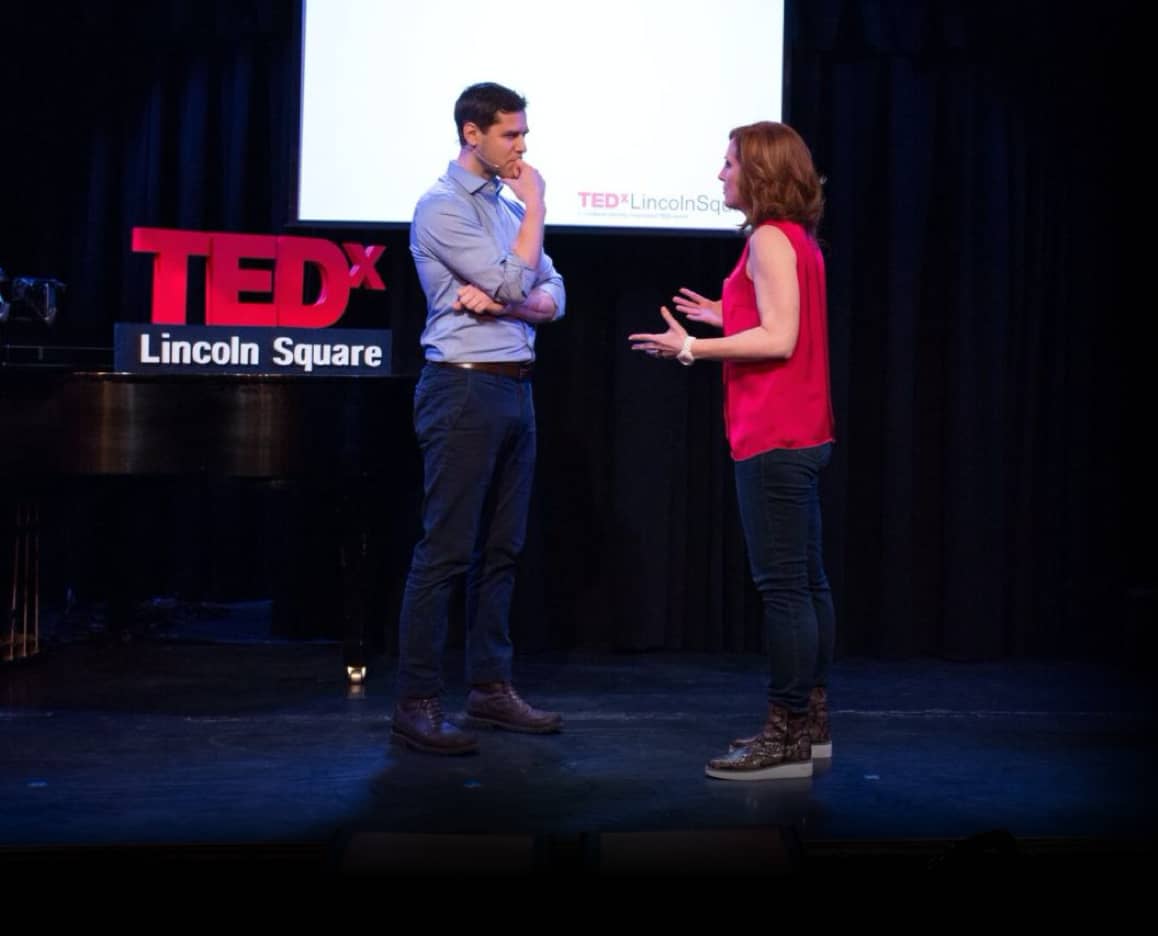Public speaking can be a very daunting and nerve-wracking task for many people. The sheer thought of getting up in front of a crowd – whether they are perfect strangers, familiar co-workers or old friends – to deliver a speech can evoke feelings of fear, anxiety, and nervousness. This is completely natural.
However, mastering the art of public speaking goes beyond the words you say. It also involves understanding and utilizing the power of body language. Your hand gestures, movements, and facial expressions have the power to make or break your presentation.
In the article below, we are going to explore the significance of body language and how it’s so important for public speaking. We’ll also pinpoint ways that you can harness its power to become a more effective communicator, on and off the stage.
Why Does Body Language Matter for Speakers?
Body language matters because it helps establish confidence, enhance communication, and connect with the audience. When used properly, your body language can convey emotions, it can reinforce your message, and it can ultimately manage your own feelings of nervousness, which will make your speech and words more impactful. When body language or behaviors aren’t used properly, it can have the opposite effect and become a distraction to the audience.
The way you carry yourself and use nonverbal cues can greatly enhance your message and captivate your audience. Below we will break down each positive role that body language plays in the art of public speaking.
1. Emitting Confidence
One of the best overall benefits of using body language effectively in public speaking is that it can ultimately establish foreboding confidence. A speaker’s posture, stance, facial expressions, and hand gestures all contribute to the overall impression you make on your audience. By standing tall, with your shoulders back and head held high, you exude confidence and authority.
Confident body language sends a subconscious message to both the audience and the speaker themselves, instilling a sense of credibility and conviction in the message being delivered. Through this positive perception of confidence, it helps the audience trust and engage with you, the speaker, while also boosting your own feelings of self-worth and reducing anxiety.
Tip: Maintain an upright posture. Don’t slouch or hunch. Make eye contact with the audience. Avoid looking up to the ceiling, or down at your shoes. Use open and expansive gestures where applicable, as this will further project an image of self-assurance.
2. Enhancing Communication
Body language serves as a powerful tool to enhance communication and reinforce the spoken words of a speaker. When used correctly, it can greatly improve the effectiveness of how your message is being conveyed to the audience.
Consider the following ways that body language can help a speaker communicate their message more effectively:
- Emphasizing Pertinent Information: Appropriate hand gestures can help draw attention to key points and add emphasis to your theme and message. For instance, using a sweeping gesture to indicate a large number or a precise gesture to highlight a specific idea can help the audience better understand and remember the important information.
- Conveying Openness and Inclusiveness: Open gestures, such as spreading the arms wide or keeping the palms facing upward, can convey openness and inclusiveness. These gestures create a welcoming atmosphere, signaling to the audience that the speaker is approachable and willing to connect with them. By using such body language, the speaker establishes a rapport and encourages active participation and involvement from the audience.
- Reinforcing Meaning: Mirroring body language with spoken words can reinforce the meaning and impact of the message. For example, nodding the head while stating agreement or using subtle gestures to mirror the actions being described can strengthen the connection between the speaker and the audience. This synchronization of body language and speech creates a cohesive experience, making the message more persuasive and convincing.
- Engaging Nonverbal Cues: Body language includes various nonverbal cues such as facial expressions, posture, and movement. These non-spoken cues can actually convey real emotions, enthusiasm, and passion, all of which greatly enhance the speaker’s ability to engage their audience and create a memorable experience. A genuine smile, animated facial expressions, and dynamic movements can captivate attention and create an energetic atmosphere. When the audience sees the speaker’s enthusiasm and conviction reflected in their body language, it helps create a positive and receptive environment for the message.
- Enhancing Overall Experience: By incorporating effective body language, a speaker creates a more impactful and memorable communication experience. When the verbal and nonverbal elements of your body language both align, the audience is more likely to retain the information you’re sharing with them, understand your overall intent, and feel that much more connected to the message. Body language serves as a visual support that complements the words, making the speech more engaging, persuasive, and compelling.
Through appropriate gestures, open postures, mirroring, and engaging nonverbal cues, a speaker can effectively emphasize important points, convey openness, reinforce meaning, and create a captivating atmosphere.
3. Establishing Connection
Establishing a strong and genuine connection with the audience can feel difficult, but it’s truly essential for effective public speaking. Your body language serves as a powerful tool to bring this about.
Listed below are five common examples of how body language can allow a speaker to build a meaningful connection with their audience:
- Creating Rapport and Approachability: Nonverbal cues, including a warm smile, an open posture, and overall friendly demeanor, can make a speaker more approachable and relatable. When the audience sees a speaker displaying positive and welcoming body language, they are more likely to feel comfortable and open to receiving the message. A genuine smile can create an instant connection and put the audience at ease, fostering a sense of rapport and receptiveness.
- Conveying Attentiveness: Small nonverbal cues like nodding, maintaining eye contact, and slight forward leans can convey attentiveness and active listening. When a speaker demonstrates these cues, it shows the audience that their presence and input are valued. This creates a sense of engagement and makes the audience feel heard, which enhances their connection with the speaker and increases their willingness to actively participate in the communication process.
- Mirror and Match: Mirroring the body language of the audience, within reasonable limits, can help establish a sense of familiarity and trust. Subtle mirroring, such as adopting similar postures or gestures, can create a subconscious sense of connection. This technique helps to build rapport and signals to the audience that the speaker understands and empathizes with them. However, it is important to be authentic and avoid overdoing the mirroring, as it should be a subtle and natural reflection of the audience’s body language.
- Emotional Connection: Body language can effectively convey emotions, and sharing emotions can create a strong bond between the speaker and the audience. By utilizing facial expressions, gestures, and body movements that align with the emotional content of the speech, a speaker can evoke similar emotions in the audience. When the audience feels that the speaker understands and shares their emotions, it deepens the connection and strengthens the impact of the message.
- Active Engagement: Engaging body language encourages audience participation and interaction. A speaker can use open gestures, inviting hand movements, and dynamic movements to energize the audience and create an environment of active engagement. By demonstrating enthusiasm and passion through body language, the speaker can inspire the audience to become actively involved in the discussion, asking questions, or sharing their thoughts. This fosters a sense of connection and collaboration, making the speech a two-way communication experience.
By displaying approachability, attentiveness, and empathy through nonverbal cues, a speaker can create a sense of rapport and engagement. Similarly, mirroring the audience’s body language, within reason, can further foster familiarity and trust, leading to increased receptiveness, active participation, and a deeper understanding and impact of the message.
4. Conveying Emotion
Emotion is a powerful tool in public speaking, and your body language can effectively convey the emotions you want to express. Facial expressions, hand gestures, and body movements can all help to evoke specific emotions in your audience. For instance, using a strong and confident posture while maintaining a serious facial expression can convey authority and seriousness.
Conversely, using open and relaxed body language with a warm smile can create a sense of enthusiasm and approachability. When you align your body language with the emotions that you’re trying to evoke, you can create a more impactful and memorable experience for your audience.
5. Managing Nervousness
Public speaking can induce nervousness, even in the most seasoned speakers. However, understanding how to use body language can help you manage your nervousness effectively. Breathing deeply and maintaining a relaxed posture can help calm your nerves and project a composed demeanor. Avoiding fidgeting or excessive movements can also help you appear more collected and in control.
By intentionally using your body language to convey calmness and confidence, you can alleviate your own anxiety and create a positive impression on your audience.
In conclusion
The power of body language in public speaking should not be underestimated. It can make the difference between a mediocre speech and a truly captivating presentation. By consciously utilizing confident posture, expressive gestures, and engaging nonverbal cues, you can enhance your communication, establish connections, convey emotions, and manage nervousness.
So, the next time you step onto the stage, remember to let your body language speak volumes alongside your words, and watch your impact as a public speaker soar to new heights.
For more tips, or if you’re interested in working with a public speaking expert to take your skill sets to a higher level, contact Tricia Brouk today.








